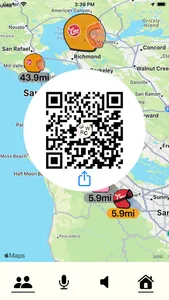With Crew Relay Chat, users can create or join rides.
A ride is an ephemeral voice and location-sharing event.
Users can share a ride using QR codes, airdrop, BlueTooth, and WWW links on social networks and messaging apps.
Users can join a ride without exchanging phone numbers or any additional information and do not need to be connected socially.
It is a solution to the painful motorcycle intercom pairing process.
A ride is temporary, and the participants are only connected while on the ride. Furthermore, separated riders do not have to guess how to rejoin the group with the proactively shared locations.
Riders will immediately know if they are the faster rider and missed a turn. Conversely, they will also know where everybody went when they are behind.
Because it uses cellphone data to connect the mobile phones, being late to kick-stand-up no longer implies that they have missed the entire ride. They can catch up.
While on the ride, anyone can add, edit or remove shared waypoints.
CREW constantly logs personal GPS locations during a ride; Users can export these logs as GPX tracks. The records only exist on the device.
The app also imports GPX files (routes, tracks, waypoints) to overlay on the map.
CREW uses peer-to-peer mesh networks to transmit audio and GPS coordinates between riders.
If the mobile connection prevents direct connections, CREW uses a dedicated RELAY (TURN) server that does not record any data.
The Local Ride is different: It connects riders with others nearby. In this case, the GPS location is periodically shared with CREW's server to perform the clustering of riders.
MotoVloggers can rejoice: Crew lets users record the voice conversation with a few convenient options. Don't worry, all parties involved will know.
Finally, with CREW, riders can share pictures between ride members directly from/to their phone gallery. This feature uses the same mesh network, so they have to be on the ride to use it.
Beware that continuous GPS usage drains the battery fast.
A ride is an ephemeral voice and location-sharing event.
Users can share a ride using QR codes, airdrop, BlueTooth, and WWW links on social networks and messaging apps.
Users can join a ride without exchanging phone numbers or any additional information and do not need to be connected socially.
It is a solution to the painful motorcycle intercom pairing process.
A ride is temporary, and the participants are only connected while on the ride. Furthermore, separated riders do not have to guess how to rejoin the group with the proactively shared locations.
Riders will immediately know if they are the faster rider and missed a turn. Conversely, they will also know where everybody went when they are behind.
Because it uses cellphone data to connect the mobile phones, being late to kick-stand-up no longer implies that they have missed the entire ride. They can catch up.
While on the ride, anyone can add, edit or remove shared waypoints.
CREW constantly logs personal GPS locations during a ride; Users can export these logs as GPX tracks. The records only exist on the device.
The app also imports GPX files (routes, tracks, waypoints) to overlay on the map.
CREW uses peer-to-peer mesh networks to transmit audio and GPS coordinates between riders.
If the mobile connection prevents direct connections, CREW uses a dedicated RELAY (TURN) server that does not record any data.
The Local Ride is different: It connects riders with others nearby. In this case, the GPS location is periodically shared with CREW's server to perform the clustering of riders.
MotoVloggers can rejoice: Crew lets users record the voice conversation with a few convenient options. Don't worry, all parties involved will know.
Finally, with CREW, riders can share pictures between ride members directly from/to their phone gallery. This feature uses the same mesh network, so they have to be on the ride to use it.
Beware that continuous GPS usage drains the battery fast.
Show More









